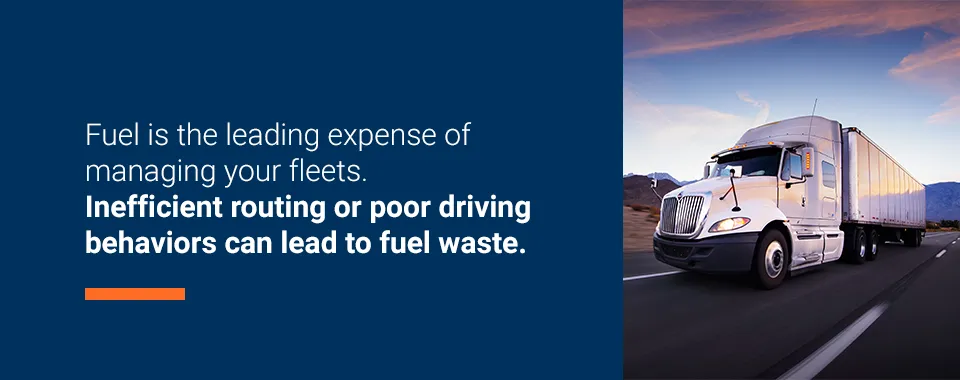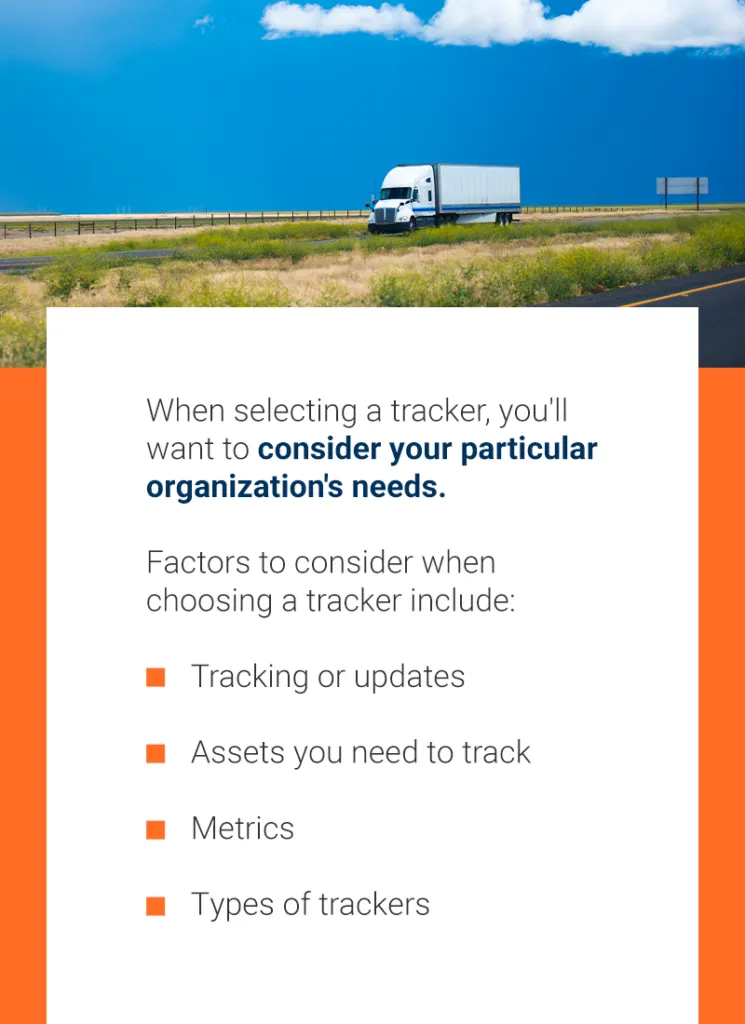

Your vehicles and equipment are one of your company’s most valuable assets, so you should adequately track and care for your fleets. Effective fleet management is a vital part of increasing fleet productivity so your company can cut costs, protect its drivers and provide optimal service. By evaluating your needs, you’ll be able to optimize fleet performance with the right tracking system.
Discover fleet management best practices to increase customer and employee satisfaction and maximize your profits.
Fleet management software collects data that helps you manage your fleet to boost productivity. Proper data collection and analysis allow for fleet utilization for maximum efficiency and cost-effectiveness. Maintaining your current fleet by tracking data expands the capacity of your existing resources so you can accept new business.
You can use telematics to optimize fleet performance. Telematics deals with monitoring fleet logistics by gathering data about driver and vehicle performance. Telematics helps you understand the bigger picture of how a vehicle operates and how it may be costing you money.
Telematics tracks multiple metrics, including:
Track Your Truck’s fleet management software records and keeps historical data about a fleet for up to one year, graphing information so you can see patterns to predict future trends. Examining historical data with telematics can help you target and address specific problem areas and establish clear fleet management policies to share with drivers.
Explain to drivers why you’re implementing the new policies, and ensure your team understands the consequences of violations. Making sure drivers clearly understand policies derived from telematics data can help them more efficiently complete tasks and drive fewer miles. For example, if you and your drivers know the locations of vehicles, you can more effectively route drivers to customers.

Fuel is the leading expense of managing your fleets. Inefficient routing or poor driving behaviors can lead to fuel waste. Drivers who quickly accelerate, brake hard, excessively idle or speed lower their gas mileage by 30% on the highway. Other drivers lack knowledge about best practices to minimize fuel usage.
For example, some drivers may think that turning off and restarting their engines will waste more fuel. However, idle commercial trucks waste 0.44 gallons of diesel per hour or 0.84 gallons of gasoline. Full delivery trucks waste even more fuel at 1.1 gallons per hour. Overall, idling engines waste more than 6 billion gallons of fuel annually.
Educating drivers about practices that lead to excessive fuel use and having a fuel conservation plan and spending program can help ensure you’re maximizing fuel efficiency to cut costs. Assign each driver a company credit card to pay when filling up their tanks so you can track how much each driver is spending and how often they’re stopping to fill up. Company cards will also help you track how much your company spends on fuel each month to prevent overspending.
Improve fleet management and minimize fuel costs further by monitoring vehicles with GPS tracking software. You’ll be able to route drivers to their destinations for maximum fuel efficiency. Shorter trips tend to waste more fuel. However, tracking software can help ensure you’re planning long enough routes. Further, you’ll be able to identify and correct bad driving habits, which use more fuel than necessary.
Tracking software can also monitor when vehicles require maintenance or when a fleet is at the end of its lifespan and needs replaced. When replacing older vehicles, consider choosing fleets with better mileage or one that would better serve your company’s specific needs and particular geographies. If you’re not ready to make replacements, maintaining your current fleets will help extend their lifespans and save more fuel.
When packing vehicles, ensure you include as little weight as possible, as excess weight leads to inefficient fuel use. A general rule of thumb is that for every 100 pounds you remove from a vehicle, you’ll increase fuel efficiency by 1-2%.

Striving to make your fleets more eco-friendly and use less fuel will save your company money while limiting greenhouse gas emissions. Fleet tracking systems allow you to find the most efficient routes, encourage positive driving habits, monitor maintenance to expand a vehicle’s lifespan and identify which vehicles are least fuel-efficient.
The Office of Energy Efficiency and Renewable Energy’s Federal Energy Program recommends a four-step fleet management program to limit petroleum use:

Regular fleet inspections help give you peace of mind that your vehicles are performing at their full capacities, preventing malfunctions and mitigating costly extensive repairs. Everyday wear and tear and corrosion decrease a truck’s productivity. Regular maintenance inspections will identify corrosion, a major cause of engine problems. Rather than waiting for issues to arise, preventative maintenance and performing vehicle diagnostic tests are key in saving your company time and money.

Keeping up with maintenance comes with multiple benefits, including:
Schedule monthly checkups for your vehicles. Conducting regularly scheduled maintenance will ensure driver safety and repair minor malfunctions before they evolve into significant damages. Technological advances like GPS tracking software automate maintenance scheduling and reports to help maximize productivity and ultimately profit.
Ways tracking software enhances maintenance scheduling to optimize fleet performance include:
In addition to performing regular preventative maintenance, you should also establish a vehicle replacement program. When vehicles require frequent repairs, you should replace them. Keeping fleets past their lifespan can lead to increased maintenance costs and even mechanical failures, costing your company more time and money. You should maintain a fleet portfolio and analyze historical data to establish replacement schedules and determine which vehicle models frequently fail.

Safe driving is a crucial fleet management best practice. Helping drivers develop safe habits will save on fuel costs and wear and tear, ensuring your vehicles can last as long as possible. Having safe drivers and properly maintained fleets will help your company build and sustain a positive reputation.
You can take the following steps to increase driver safety:
Covert tracking can help you discreetly monitor and target negative behavior without the driver even realizing. These trackers keep drivers from disabling the devices and prevent accidental unplugging. Because covert trackers are hidden, they can also alert you to theft and help you recover the vehicle or notify you when a vehicle is being used outside of approved times.
Efficient route planning with fleet management software helps drivers feel less rushed — and therefore less stressed — and keeps customer satisfaction high by safely delivering products or services on time. Some drivers are prone to speeding due to an inefficient route or a failure to plan for factors like traffic, breaks or construction. Using a vehicle speed tracking system can help you plan the most efficient routes to prevent speeding, set boundaries in particular speed limit zones or set alerts when drivers exceed a certain speed.

The Federal Motor Carrier Safety Administration (FMCSA) requires drivers who must keep records of duty service to have an electronic logging device (ELD). ELDs virtually log fleet data and driver hours to ensure drivers remain compliant with hours of service (HOS) laws and stay alert while driving. You’ll want to ensure you stay compliant with the ELD rule, as penalties can cost thousands of dollars.
ELDs are proven to increase compliance with HOS laws by automatically recording how long an engine is running, whether a vehicle is moving, how many miles a driver traveled and whether a driver took the required breaks.
ELDs come with a variety of benefits, including:
Fleets are also subject to state and federal regulations. You should stay on top of preventative maintenance to give your drivers more confidence during inspections and have a higher compliance, safety and accountability (CSA) score. You should also ensure you’re up to date with licensing requirements to avoid paying late or non-compliance fees.
One of the most effective fleet management techniques is tracking your trucks with fleet management systems. You can find the most optimized routes for improved customer satisfaction and provide more accurate arrival estimates by checking how long each delivery takes and evaluating the effectiveness of different routes. Maintaining high customer satisfaction helps customers stay loyal to your company.

Fleet tracking comes with a variety of other benefits, including:
When selecting a tracker, you’ll want to consider your particular organization’s needs. Factors to consider when choosing a tracker include:

Because your fleets are a valuable asset to your company, you’ll want to practice effective fleet management. Track Your Truck’s fleet tracking systems can ensure you’re properly maintaining your fleets to maximize productivity and profits. Our software will scale with your business, with all programming updates and changes done in-house, individualized customer support and access to a customer service site with training materials.
Contact Track Your Truck today to request a free quote and learn how our fleet tracking systems can help you optimize fleet performance!
